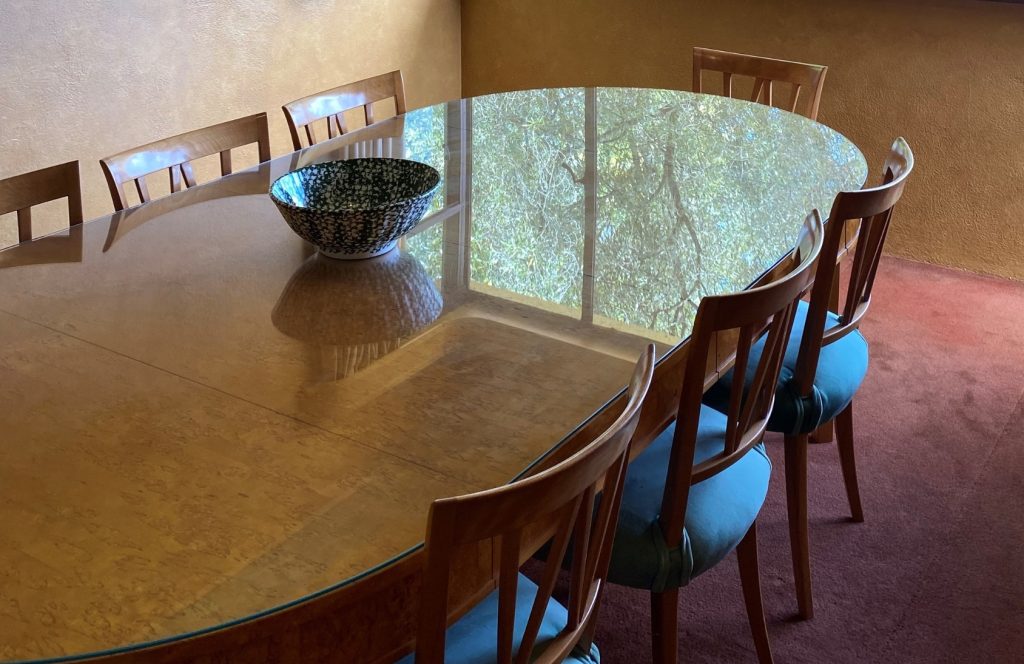With the onset of warmer weather and longer days, now is the perfect time to dust off the chill of winter and give your house a thorough spring clean. Our Collections Manager Rebecca Pinchin reveals her expert advice to cleaning surfaces, furniture and precious pieces in your home using the methods employed by the National Trust (NSW).
Where is the best place to start?
At the very top. In a house or a room, you clean top down rather than bottom up because dust settles.
What is the essential kit?
What we use at the National Trust is applicable to normal household cleaning too. First is a vacuum – choose one with a High Efficiency Particulate Air (HEPA) filter as it removes the fine particle constituents of dust. An adjustable nozzle is also key, as is adjustable speed to ensure that you can control the amount of suction. The other essential item is microfibre cloths. They come in all different grades, and they do the job far more effectively than any other dusting material. They can pick up mould, bacteria and even viruses off surfaces – they’re incredible. A small stiff brush is also helpful for cleaning objects. Whenever there is mould involved you should always wear a mask and gloves.
Can you recommend any cleaning products?
We don’t normally use any products at the National Trust but if there is a need for cleaning mould or dirt our go-to is a vinegar-water solution. This is comprised of 80% vinegar and 20% water. Vinegar on its own won’t kill mould. The water in the solution tricks the mould into absorbing the fluid, which then kills it. It’s also an effective solution for general cleaning – simply spray it lightly on a microfibre cloth. You do end up with your house smelling like a fish and chip shop but then if you open the house up and allow it to air, the smell of vinegar quickly dissipates!

How do you prevent mould?
Mould is controlled by three things: circulation, dust and level of humidity. If you can try and control just two of these factors you can probably control mould. Open windows and doors or use fans to ensure air is circulating in a room. Dust is the food mould lives on, so ensure that you regularly clean and wipe down surfaces. A dehumidifier is helpful for humidity.
What are your top tips for cleaning precious or delicate objects?
Use a fine microfibre cloth or a brush and a vacuum cleaner. Working from top to bottom, gently brush the dust from the surface of the object while holding the vacuum cleaner at low speed a few centimetres away. This way the dust is removed from the environment as you brush. You may think you are not having much of an impact when you are in the process of cleaning, but when you stand back and have a look afterwards it is amazing how different the item will look. This method is also the best way to clean picture frames – just lay them horizontally on a table first.
How can you avoid accidental breakages when it comes to cleaning precious or sentimental items?
Cleaning or moving objects is the time when they are most at risk. Accidents do happen! But to minimise risk always have a clear pathway of where you are moving something to. If you are moving large items or precious things it is also important to have someone there to open doors for you. Think about how you will handle an object before you start. When lifting objects use two hands and take the weight of the object with one hand underneath. Don’t pick up picture frames from the top or ceramics at weak points such as the handles of a jug.
What is a little-known tip for spring cleaning?
You can put things out in the sun for a short period to sanitise them – sunshine is the perfect way to refresh items like cushions.

What is the secret to streak-free windows?
Don’t wash your windows when sun is shining on the glass. The fluid will evaporate too quickly leaving behind streaky marks.
How do you clean wooden surfaces or furniture?
We use a dry microfibre cloth –We’re very cautious of using any type of product on timber. We never use oil-based furniture polishes as they tend to not dry and harden but rather sit on the surface and collect dust. If furniture is waxed all you need is an old t-shirt or a piece of finely woven cotton to buff it to a lovely shine again.
What is the best way to store items you no longer wish to display?
A dry place is best for storage. Wrap things in acid-free tissue paper – it acts as a barrier and protects the objects from dust. The more you enclose an item, the more you will control the environment it is stored in.
Image of Saumarez Homestead by Jarrad Stevenson.
Interested in helping to care for our special places? Discover how to become a volunteer with the National Trust. Find out more.

 Twitter
Twitter Facebook
Facebook Linkedin
Linkedin Email
Email